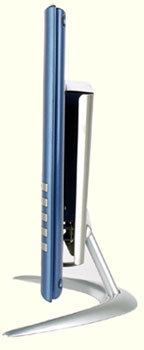Comparison Of 15" LCD Monitors - Part I
LCD Or CRT? That Is The Question
The first advantage of having an LCD display - no geometry problems. This breed of monitors makes short work of distortion, trapezoid settings and brightness distribution. The picture is geometrically perfect. Graphic designers who are fanatics about precision will go ape over this monitor. Unfortunately, there are also serious drawbacks, which might prevent artists from really going to town with this technology.
Drawback 1:
The contrast for CRTs can go as high as 700:1. The crème de la crème among today's crop of 15" LCDs have to make do with 450:1. And models with contrast ratios of 250:1 or even 200:1 aren't exactly rare, either. These low contrast ratios cause darker shades to be displayed as black. Any details that depend on these color gradations get lost in the process. Even gamers are affected by the problem, since displays suffering from really low contrast ratios will only be able to reproduce sequences in dull, drab colors.
Drawback 2:
Practically all manufacturers claim that their monitors display 16 million colors. The ceiling for most of them used to be 260,000 colors, a level at which the Neovo F-15 is still holding steady. It makes do with a 16-bit color display, although it claims to be able to display 24 bits. Overall, though, the displays appear to have made enormous strides in the past year, even if they haven't yet been able to match the CRT's color spectrum. Instead of displaying colors that melt seamlessly into one another, images evidence a grainy, speckled texture. You get a similar effect if you reduce the number of colors in Windows.
Drawback 3:
If you've got a newer CRT monitor, you wouldn't dream of using a refresh rate slower than 85 Hz. And while the maximum refresh rate of a CRT monitor is a good yardstick for its quality, this isn't the case for a comparable LCD monitor. In a cathode-ray tube, an electron beam scans the image onto the panel. The faster it can scan the panel, the better the display, and, consequently, the higher the refresh rate. Ideally, you would set your CRT to run at 85 to 100 Hz. In an LCD monitor, the image isn't created by an electron beam, but by pixel triads, each consisting of a red, green and blue subpixel. The image quality depends on how rapidly these diodes can be turned on and off again. This rapidity is known as the response time. For the monitors we tested, the response time ran the gamut from 25 to 50 ms. In other words, the maximum number of images displayed per second varied between 20 and 40, depending on the model.
Get Tom's Hardware's best news and in-depth reviews, straight to your inbox.
Current page: LCD Or CRT? That Is The Question
Prev Page The Progress Made During The Year Next Page LCD Vs CRT: An Overview
